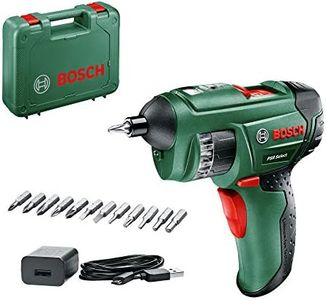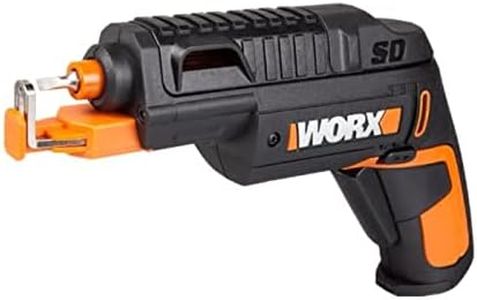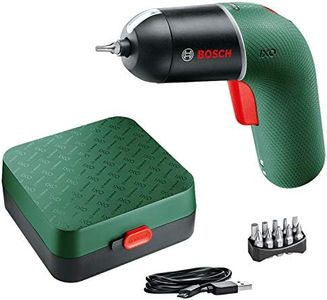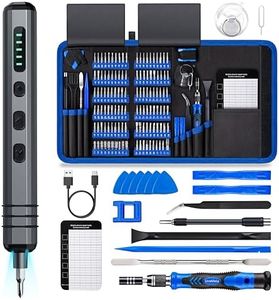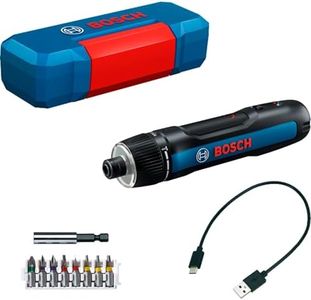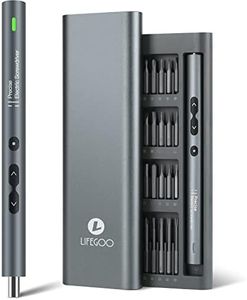We Use CookiesWe use cookies to enhance the security, performance,
functionality and for analytical and promotional activities. By continuing to browse this site you
are agreeing to our privacy policy
10 Best Mini Electric Screwdriver
From leading brands and best sellers available on the web.Buying Guide for the Best Mini Electric Screwdriver
Choosing a mini electric screwdriver is about finding the right mix of power, convenience, and versatility for your household or DIY needs. These compact tools are designed to handle light to medium screw-driving tasks, making them perfect for assembling furniture, fixing appliances, or tackling tech repairs. You want a tool that is easy to handle, fits into tight spaces, and has enough battery life to get jobs done without frequent recharges. Knowing what tasks you will mainly use it for will help you focus on the features that matter most.TorqueTorque is the measure of twisting force the screwdriver can apply, and it essentially tells you how powerful the tool is. Low torque is enough for assembling electronics or small household fixes, while higher torque is better for tougher tasks like screwing into dense wood or thicker materials. Most mini electric screwdrivers will range from very low to moderate torque, making them safe for delicate jobs. Think about what you’ll use your screwdriver for most: if you’re mainly working with small gadgets or toy repairs, the lowest setting is enough. If you'll do light carpentry or often handle stuck screws, more torque is better. Some models offer adjustable torque settings, giving you more flexibility.
Speed (RPM)Speed, measured in revolutions per minute (RPM), indicates how quickly the screwdriver turns. Low RPM is slower but offers better control for sensitive tasks, while higher RPM is useful for speeding through longer screws or repetitive tasks. If you need precision (like opening a laptop), slower speed is safer. For quick assembly (like flat-pack furniture), higher speed saves time. Look for a screwdriver with variable speed or one where the speed matches your main tasks. For most home users, mid-range RPM is both safe and effective.
Battery Type and LifeThe battery determines how long you can use the screwdriver before it needs recharging. Most mini electric screwdrivers use rechargeable lithium-ion batteries, which hold their charge well and recharge quickly. If you need a tool for occasional short tasks, battery life won’t be an issue. But for frequent use or longer projects, look for higher capacity batteries or faster charging times. Pay attention also to whether the battery is removable (for easy swapping) or built-in (lighter but fixed).
Size and WeightA key advantage of mini electric screwdrivers is their compactness. Size and weight affect how easy the tool is to handle, especially in tight or awkward spaces. Lighter and smaller models are perfect for electronics, toy repairs, and situations where you need a steady hand. If you sometimes need a bit more force, a slightly bigger tool can give you a better grip. Choose the smallest model that still feels comfortable to hold and matches your main tasks.
Chuck Type and Bit CompatibilityThe chuck is the part that holds the screwdriver bits. Some mini electric screwdrivers use small, unique chucks suitable only for included bits, while others use standard magnetic 1/4-inch chucks compatible with widely available bits. If you plan to use a variety of screw sizes and heads, or already own bits, a standard chuck gives you more flexibility. For simple, light work, fixed chucks are perfectly sufficient. Pick what matches your most common screw types and make sure changing bits is easy.
Built-in LightingMany mini electric screwdrivers have small LED lights built in near the tip to illuminate your work, which can be very helpful in dark or tight spots. If you expect to work in poor lighting or inside cabinets and appliances, this feature can make tasks much easier. If you always work in well-lit areas, it may be less important, but it's a useful bonus for many people.
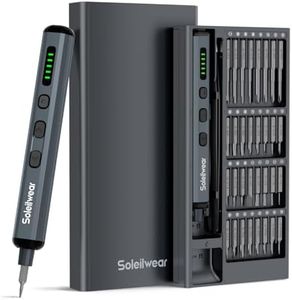





![37 in 1 Mini Electric Screwdriver, [0.05-0.25Nm Torque] Homtronics Small Electric Precision Power Screwdriver Set, LED Light, Rechargeable Repair Tool Kit for Phone, Laptop, Camera, Glasse (Grey)](https://images-proxy.bestreviews.guide/ByXFHjUFld8Ua6TfFX_MLMxUAvA=/0x300/https://m.media-amazon.com/images/I/41tZfPb3U7L._AC_CX679_.jpg)
